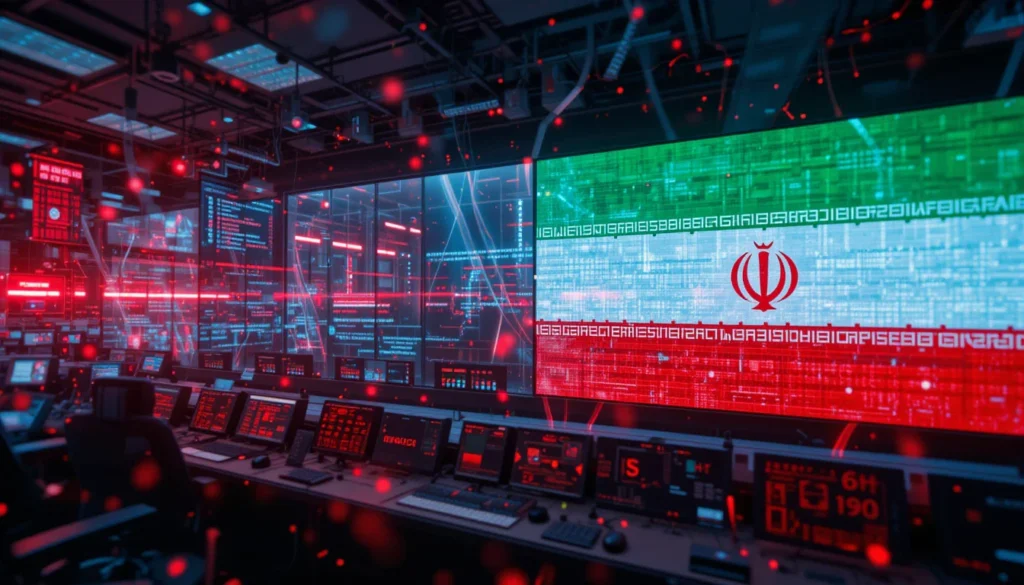Overview
In the wake of recent geopolitical tensions, Iran-linked hacktivist groups have escalated cyberattacks on U.S. critical infrastructure, including energy grids, water treatment facilities, and transportation networks. Cybersecurity experts warn that these attacks—fueled by retaliation motives—pose a serious national security risk. This surge follows a high-profile missile strike in the Middle East involving U.S. assets, and hacktivists appear to be targeting symbolic and high-impact systems.
Key Facts
- Focus Keyword: Iran-Linked Hacktivists
- Cyberattacks on critical U.S. infrastructure have spiked since June 2025.
- Industrial Control Systems (ICS) in power and water utilities have seen probing activity.
- Anonymous affiliated groups like CyberAv3ngers and DarkBit are suspected.
- Targets include airports, railway systems, and healthcare networks.
- The Department of Homeland Security (DHS) and CISA have issued joint threat advisories.
- The FBI confirmed multiple cyber incidents are under investigation.
- Attribution points to Iranian threat actors using VPN obfuscation and proxy chaining.
What’s Verified and What’s Still Unclear
Verified:
- A rise in attempted ICS intrusions using publicly available tools like Shodan and Censys.
- Iranian Telegram channels have claimed responsibility for minor disruptions.
- Coordinated phishing and wiper malware campaigns have been detected.
- Real-world disruptions to two municipal water treatment plants in Texas and New Jersey.
Unclear:
- Full scope of compromised systems across the U.S.
- Whether state-level actors are directly orchestrating these attacks.
- The extent of collaboration between hacktivists and Iranian intelligence units.
- Whether any physical infrastructure damage has occurred yet.
Timeline of Events
- June 11, 2025: U.S. drone strike targets IRGC general in Syria.
- June 13, 2025: “CyberAv3ngers” announce campaign against “American control systems.”
- June 14–17, 2025: CISA detects scanning and brute force attempts on SCADA endpoints.
- June 18, 2025: Newark water treatment plant experiences system downtime.
- June 20, 2025: Anonymous-linked account posts footage of airport system interface.
- June 22, 2025: DHS and FBI confirm “likely Iranian origins” of threats.
Who’s Behind It?
The primary actors are Iranian hacktivist groups such as CyberAv3ngers, DarkBit, and Homeland Justice, which have a track record of targeting Israeli, European, and U.S. infrastructure. These groups are often linked to the Islamic Revolutionary Guard Corps (IRGC) or operate with ideological alignment. Although many claim to be grassroots cyber collectives, their TTPs (Tactics, Techniques, and Procedures) show operational overlaps with APT33 (Elfin) and APT39, known state-sponsored groups.
Public & Industry Response
- CISA issued a new SHIELDS UP advisory recommending enhanced logging, 2FA, and ICS segmentation.
- Microsoft and Dragos released detection rules for recent malware strains.
- Public trust in utility services saw a 12% dip in affected cities.
- Social media saw misinformation campaigns claiming blackouts were imminent, debunked by officials.
- Water and energy authorities are collaborating with the National Guard cyber units.
What Makes This Unique?
Unlike earlier politically motivated defacements or ransomware-for-profit campaigns, this wave is ideologically charged, targeted, and persistent. The emphasis on symbolic critical infrastructure—not for extortion but for disruption—indicates a shift toward cyber-sabotage as a retaliatory tactic. The blend of hacktivism and statecraft blurs lines, complicating response efforts.
Additionally, the use of AI-generated phishing content, deepfake audio impersonations of government officials, and OT system emulators makes these attacks far more technically advanced than prior hacktivist campaigns.
Understanding the Basics
What is a Hacktivist?
A hacktivist is an individual or group that uses hacking to promote a political or ideological agenda. Iran-linked hacktivists often claim they are retaliating against what they perceive as U.S. aggression in the Middle East.
What is Critical Infrastructure?
Critical infrastructure includes essential systems and assets such as electricity grids, water supplies, hospitals, airports, and railways—any disruption to these can lead to societal and economic chaos.
What Happens Next?
Experts anticipate that low-cost, high-impact cyber tactics will continue, especially around major U.S. holidays and upcoming elections. Here’s what to expect:
- Increased Spear-Phishing campaigns targeting infrastructure employees.
- Possible data leaks from ICS vendors and suppliers.
- Heightened geopolitical cyber posturing from both Iran and the U.S.
- Expanded cyber drills and tabletop exercises across state-level agencies.
- Ongoing collaboration between private sector threat intel teams and federal bodies.
Summary
The threat posed by Iran-linked hacktivists to U.S. critical infrastructure represents a new phase of cyber conflict where ideological warfare meets technical sophistication. With escalating geopolitical tensions, these cyber campaigns are likely to persist, evolve, and challenge national cyber resilience. Proactive defense, public-private coordination, and real-time threat intelligence sharing are now more crucial than ever.
